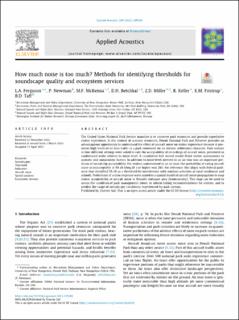| dc.contributor.author | Ferguson, Lauren A. | |
| dc.contributor.author | Newman, P. | |
| dc.contributor.author | McKenna, M. | |
| dc.contributor.author | Betchkal, D.H. | |
| dc.contributor.author | Miller, Z.D. | |
| dc.contributor.author | Keller, Rose | |
| dc.contributor.author | Fristrup, K.M. | |
| dc.contributor.author | Taff, B. Derrick | |
| dc.coverage.spatial | Alaska, United states of America, USA | en_US |
| dc.date.accessioned | 2023-05-22T08:08:25Z | |
| dc.date.available | 2023-05-22T08:08:25Z | |
| dc.date.created | 2023-05-16T14:07:56Z | |
| dc.date.issued | 2023 | |
| dc.identifier.issn | 0003-682X | |
| dc.identifier.uri | https://hdl.handle.net/11250/3068433 | |
| dc.description.abstract | The United States National Park Service mandate is to conserve park resources and provide superlative visitor experience. In the context of acoustic resources, Denali National Park and Preserve provides an advantageous opportunity to understand the effect of aircraft noise on visitor experience because it possesses high levels of air tour traffic in a park renowned for its remote, wilderness character. Park visitors in four different settings were asked to rate the acceptability of recordings of aircraft noise, presented in randomized order relative to noise level. A cumulative link mixed model fitted visitor assessments to acoustic and nonacoustic factors. In addition to noise level, interest in an air tour was an important predictor of sound clip acceptability. For visitors uninterested in an air tour, the probability of rating aircraft noise as unacceptable at 54 dB LAeq,30 s or higher was 26%. For reference, this aligns with federal guidance that identified 55 dB as a threshold for interference with outdoor activities at rural residences and schools. Predictions of visitor response were joined to a spatial model of aircraft noise propagation to map visitor acceptability of aircraft noise in Denali’s entrance area (frontcountry). This map can be used to assess the condition of park management zones, to inform hiking recommendations for visitors, and to predict the range of soundscape conditions experienced by park visitors Soundscapes Threshold Indicators Aircraft noise Spatial analysis Ecosystem services | en_US |
| dc.language.iso | eng | en_US |
| dc.rights | Navngivelse 4.0 Internasjonal | * |
| dc.rights.uri | http://creativecommons.org/licenses/by/4.0/deed.no | * |
| dc.subject | Soundscapes | en_US |
| dc.subject | Threshold | en_US |
| dc.subject | Indicators | en_US |
| dc.subject | Aircraft noise | en_US |
| dc.subject | Spatial analysis | en_US |
| dc.subject | Ecosystem services | en_US |
| dc.title | How much noise is too much? Methods for identifying thresholds for soundscape quality and ecosystem services | en_US |
| dc.title.alternative | How much noise is too much? Methods for identifying thresholds for soundscape quality and ecosystem services | en_US |
| dc.type | Peer reviewed | en_US |
| dc.type | Journal article | en_US |
| dc.description.version | publishedVersion | en_US |
| dc.rights.holder | © 2023 The Authors | en_US |
| dc.subject.nsi | VDP::Samfunnsvitenskap: 200::Samfunnsgeografi: 290 | en_US |
| dc.source.volume | 209 | en_US |
| dc.source.journal | Applied Acoustics | en_US |
| dc.identifier.doi | 10.1016/j.apacoust.2023.109388 | |
| dc.identifier.cristin | 2147855 | |
| dc.relation.project | Andre: National Park Service, CESU P14AC00921 | en_US |
| dc.source.articlenumber | 109388 | en_US |
| cristin.ispublished | true | |
| cristin.fulltext | original | |
| cristin.qualitycode | 1 | |

